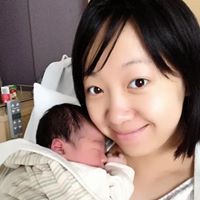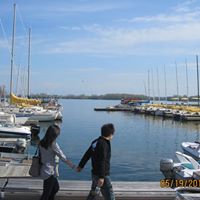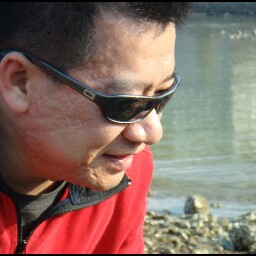Xiao Gen Liu
age ~69
from San Francisco, CA
- Also known as:
-
- Xiaogen G Liu
- Xiaogen Lu
- Jen Liu Xiaogen
Xiao Liu Phones & Addresses
- San Francisco, CA
- Daly City, CA
- 15905 127Th St, Olathe, KS 66062
- Fort Lee, NJ
- Shawnee Mission, KS
- Overland Park, KS
Isbn (Books And Publications)

Lawyers & Attorneys

Xiao Liu, New York NY - Lawyer
view sourceAddress:
Skadden, Arps, Slate, Meagher & Flom LLP
4 Times Sq, New York, NY 10036
2127353000 (Office)
4 Times Sq, New York, NY 10036
2127353000 (Office)
Licenses:
New York - Currently registered 2012
Education:
Harvard Law School

Xiao Jeff Liu - Lawyer
view sourceAddress:
Gide Loyrette Nouel
Licenses:
New York - Currently registered 2011
Education:
University of Michigan Law School
Us Patents
-
Method And Apparatus For Growing Semiconductor Crystals With A Rigid Support With Carbon Doping And Resistivity Control And Thermal Gradient Control
view source -
US Patent:6896729, May 24, 2005
-
Filed:Jul 3, 2002
-
Appl. No.:10/190001
-
Inventors:Xiao Gordon Liu - Fremont CA, US
Wei Guo Liu - Sunnyvale CA, US -
Assignee:AXT, Inc. - Fremont CA
-
International Classification:C30B011/06
-
US Classification:117 81, 117 82, 117 83, 117223
-
Abstract:Group III-V, II-VI and related monocrystalline compounds are grown with a rigid support of a sealed ampoule, carbon doping and resistivity control, and thermal gradient control in a crystal growth furnace. A support cylinder provides structural support for the combined sealed ampoule crucible assembly, while low-density insulating material inside the support cylinder deters convection and conduction heating. Radiation channels penetrating the low-density material provide pathways for radiation heating into and out of the seed well and transition regions of the crystal growth crucible. A hollow core in the insulation material directly beneath the seed well provides cooling in the center of the growing crystal, which enables uniform, level growth of the crystal ingot and a flat crystal-melt interface which results in crystal wafers with uniform electrical properties.
-
Silicon Chip Carrier With Conductive Through-Vias And Method For Fabricating Same
view source -
US Patent:7276787, Oct 2, 2007
-
Filed:Dec 5, 2003
-
Appl. No.:10/729254
-
Inventors:Daniel Charles Edelstein - White Plains NY, US
Paul Stephen Andry - Mohegan Lake NY, US
Leena Paivikki Buchwalter - Hopewell Junction NY, US
Jon Alfred Casey - Poughkeepsie NY, US
Sherif A. Goma - Hawthorne NY, US
Raymond R. Horton - Dover Plains NY, US
Gareth Geoffrey Hougham - Ossining NY, US
Michael Wayne Lane - Cortlandt Manor NY, US
Xiao Hu Liu - Croton on Hudson NY, US
Chirag Suryakant Patel - Peekskill NY, US
Edmund Juris Sprogis - Underhill VT, US
Michelle Leigh Steen - Danbury CT, US
Brian Richard Sundlof - Beacon NY, US
Cornelia K. Tsang - Mohegan Lake NY, US
George Frederick Walker - New York NY, US -
Assignee:International Business Machines Corporation - Armonk NY
-
International Classification:H01L 23/48
H01L 23/498
H01L 21/4763
H01L 29/40
H01L 23/52 -
US Classification:257698, 257E23067, 257E23075, 257E23011, 257E25013, 257E21597, 257E23006, 257E23172, 257E23174, 257774, 257773, 257702, 257680, 257700, 257758
-
Abstract:A carrier structure and method for fabricating a carrier structure with through-vias each having a conductive structure with an effective coefficient of thermal expansion which is less than or closely matched to that of the substrate, and having an effective elastic modulus value which is less than or closely matches that of the substrate. The conductive structure may include concentric via fill areas having differing materials disposed concentrically therein, a core of the substrate material surrounded by an annular ring of conductive material, a core of CTE-matched non-conductive material surrounded by an annular ring of conductive material, a conductive via having an inner void with low CTE, or a full fill of a conductive composite material such as a metal-ceramic paste which has been sintered or fused.
-
Heat-Shielded Low Power Pcm-Based Reprogrammable Efuse Device
view source -
US Patent:7394089, Jul 1, 2008
-
Filed:Aug 25, 2006
-
Appl. No.:11/467294
-
Inventors:James P. Doyle - Bronx NY, US
Bruce G. Elmegreen - Golden Bridge NY, US
Lia Krusin-Elbaum - Dobbs Ferry NY, US
Chung Hon Lam - Peekskill NY, US
Xiao Hu Liu - Briarcliff Manor NY, US
Dennis M. Newns - Yorktown Heights NY, US
Christy S. Tyberg - Mahopac NY, US -
Assignee:International Business Machines Corporation - Armonk NY
-
International Classification:H01L 47/00
-
US Classification:257 4, 257209, 257529, 257E2917
-
Abstract:An electrically re-programmable fuse (eFUSE) device for use in integrated circuit devices includes an elongated heater element, an electrically insulating liner surrounding an outer surface of the elongated heater element, corresponding to a longitudinal axis thereof, leaving opposing ends of the elongated heater element in electrical contact with first and second heater electrodes. A phase change material (PCM) surrounds a portion of an outer surface of the electrically insulating liner, a thermally and electrically insulating layer surrounds an outer surface of the PCM, with first and second fuse electrodes in electrical contact with opposing ends of the PCM. The PCM is encapsulated within the electrically insulating liner, the thermally and electrically insulating layer, and the first and second fuse electrodes.
-
Negative Thermal Expansion System (Ntes) Device For Tce Compensation In Elastomer Composites And Conductive Elastomer Interconnects In Microelectronic Packaging
view source -
US Patent:7417315, Aug 26, 2008
-
Filed:Dec 5, 2002
-
Appl. No.:10/310532
-
Inventors:Gareth Geoffrey Hougham - Ossining NY, US
S. Jay Chey - Ossining NY, US
James Patrick Doyle - Bronx NY, US
Xiao Hu Liu - Croton On Hudson NY, US
Christopher V. Jahnes - Upper Saddle River NJ, US
Paul Alfred Lauro - Brewster NY, US
Nancy C. LaBianca - Yalesville CT, US
Michael J. Rooks - Briarcliff Manor NY, US -
Assignee:International Business Machines Corporation - Armonk NY
-
International Classification:H01L 21/302
B32B 5/22
G02B 26/00 -
US Classification:257747, 257758, 257E2308, 257E23128, 4283179, 359291
-
Abstract:A Negative Thermal Expansion system (NTEs) device for TCE compensation or CTE compensation in elastomer composites and conductive elastomer interconnects in microelectronic packaging. One aspect of the present invention provides a method for fabricating micromachine devices that have negative thermal expansion coefficients that can be made into a composite for manipulation of the TCE of the material. These devices and composites made with these devices are in the categories of materials called “smart materials” or “responsive materials. ” Another aspect of the present invention provides microdevices comprised of dual opposed bilayers of material where the two bilayers are attached to one another at the peripheral edges only, and where the bilayers themselves are at a minimum stress conditions at a reference temperature defined by the temperature at which the bilayers are formed. These devices have the technologically useful property of volumetrically expanding upon lowering of the device temperature below the reference or processing temperature.
-
Heat-Shielded Low Power Pcm-Based Reprogrammable Efuse Device
view source -
US Patent:7491965, Feb 17, 2009
-
Filed:May 28, 2008
-
Appl. No.:12/127994
-
Inventors:James P. Doyle - Bronx NY, US
Bruce G. Elmegreen - Golden Bridge NY, US
Lia Krusin-Elbaum - Dobbs Ferry NY, US
Chung Hon Lam - Peekskill NY, US
Xiao Hu Liu - Briarcliff Manor NY, US
Dennis M. Newns - Yorktown Heights NY, US
Christy S. Tyberg - Mahopac NY, US -
Assignee:International Business Machines Corporation - Armonk NY
-
International Classification:H01L 47/00
-
US Classification:257 4, 257209, 257529, 257E2917
-
Abstract:An electrically re-programmable fuse (eFUSE) device for use in integrated circuit devices includes an elongated heater element, an electrically insulating liner surrounding an outer surface of the elongated heater element, corresponding to a longitudinal axis thereof, leaving opposing ends of the elongated heater element in electrical contact with first and second heater electrodes. A phase change material (PCM) surrounds a portion of an outer surface of the electrically insulating liner, a thermally and electrically insulating layer surrounds an outer surface of the PCM, with first and second fuse electrodes in electrical contact with opposing ends of the PCM. The PCM is encapsulated within the electrically insulating liner, the thermally and electrically insulating layer, and the first and second fuse electrodes.
-
Negative Thermal Expansion System (Ntes) Device For Tce Compensation In Elastomer Composites And Conductive Elastomer Interconnects In Microelectronic Packaging
view source -
US Patent:7556979, Jul 7, 2009
-
Filed:Oct 31, 2007
-
Appl. No.:11/932385
-
Inventors:Gareth Geoffrey Hougham - Ossining NY, US
S. Jay Chey - Ossining NY, US
James Patrick Doyle - Bronx NY, US
Xiao Hu Liu - Croton On Hudson NY, US
Christopher V. Jahnes - Upper Saddle River NJ, US
Paul Alfred Lauro - Brewster NY, US
Nancy C. LaBianca - Yalesville CT, US
Michael J. Rooks - Briarcliff Manor NY, US -
Assignee:International Business Machines Corporation - Armonk NY
-
International Classification:H01L 21/00
-
US Classification:438 53, 257E21254, 257E27008
-
Abstract:A Negative Thermal Expansion system (NTEs) device for TCE compensation or CTE compensation in elastomer composites and conductive elastomer interconnects in microelectronic packaging. One aspect of the present invention provides a method for fabricating micromachine devices that have negative thermal expansion coefficients that can be made into a composite for manipulation of the TCE of the material. These devices and composites made with these devices are in the categories of materials called “smart materials” or “responsive materials. ” Another aspect of the present invention provides microdevices comprised of dual opposed bilayers of material where the two bilayers are attached to one another at the peripheral edges only, and where the bilayers themselves are at a minimum stress conditions at a reference temperature defined by the temperature at which the bilayers are formed. These devices have the technologically useful property of volumetrically expanding upon lowering of the device temperature below the reference or processing temperature.
-
Negative Coefficient Of Thermal Expansion Particles And Method Of Forming The Same
view source -
US Patent:7579069, Aug 25, 2009
-
Filed:Nov 6, 2003
-
Appl. No.:10/702280
-
Inventors:Gareth Geoffrey Hougham - Ossining NY, US
Xiao Hu Liu - Croton On Hudson NY, US
S. Jay Chey - Ossining NY, US
James Patrick Doyle - Bronx NY, US
Joseph Zinter, Jr. - Brewster NY, US
Michael J. Rooks - Briarcliff Manor NY, US
Brian Richard Sundlof - Beacon NY, US
Jon Alfred Casey - Poughkeepsie NY, US -
Assignee:International Business Machines Corporation - Armonk NY
-
International Classification:B32B 15/02
-
US Classification:4283133, 4283134, 4283139, 428570, 252512
-
Abstract:A negative coefficient of thermal expansion particle includes a first bilayer having a first bilayer inner layer and a first bilayer outer layer, and a second bilayer having a second bilayer inner layer and a second bilayer outer layer. The first and second bilayers are joined together along perimeters of the first and second bilayer outer layers and first and second bilayer inner layers, respectively. The first bilayer inner layer and the second bilayer inner layer are made of a first material and the first bilayer outer layer and the second bilayer outer layer are made of a second material. The first material has a greater coefficient of thermal expansion than that of the second material.
-
Methods Of Treating An Inflammatory-Related Disease
view source -
US Patent:7582670, Sep 1, 2009
-
Filed:Apr 13, 2005
-
Appl. No.:11/104422
-
Inventors:Longgui Wang - Flushing NY, US
Xiao Mei Liu - Flushing NY, US
Lian Mo - Palo Alto CA, US
Simon K. Mencher - New York NY, US -
Assignee:Natrogen Therapeutics, Inc. - Milwaukee WI
-
International Classification:A61K 31/40
A61K 31/404
A61K 31/56 -
US Classification:514414, 514415, 514416, 514406, 514171, 51425409, 514570, 514159
-
Abstract:The invention relates to pharmaceutical compositions and methods of treating inflammatory-related diseases associated with pro-inflammatory cytokine expression and/or reduced expression of anti-inflammatory cytokines. The method typically comprises administration of one or more compounds selected from isoindigo, indigo, indirubin, or derivatives thereof, such as, Meisoindigo and NATURA. Preferably the pharmaceutical composition comprises one or more compounds selected from isoindigo, indigo, indirubin, or derivatives thereof, an anti-inflammatory agent, and a pharmaceutically acceptable carrier.
Resumes

Xiao Liu Hicksville, NY
view sourceWork:
ClassWish.org
New York, NY
Apr 2014 to Jun 2014
Internship Hofstra University
Nov 2012 to Sep 2013
Resident Safety Representative Bank of East Asia (China) Co., LTD
Feb 2012 to Apr 2012
Internship --- Customer Manager Assistant Beijing Xingfu Property Management Agency Co., LTD
Jul 2010 to Aug 2010
Internship --- Accounting Assistant
New York, NY
Apr 2014 to Jun 2014
Internship Hofstra University
Nov 2012 to Sep 2013
Resident Safety Representative Bank of East Asia (China) Co., LTD
Feb 2012 to Apr 2012
Internship --- Customer Manager Assistant Beijing Xingfu Property Management Agency Co., LTD
Jul 2010 to Aug 2010
Internship --- Accounting Assistant
Education:
Frank G. Zarb School of Business, Hofstra University
Hempstead, NY
Apr 2000 to May 2014
Master of Science in Accounting Program Capital University of Economics and Business
Apr 2000 to Jul 2012
Bachelor of Business Administration in Accounting
Hempstead, NY
Apr 2000 to May 2014
Master of Science in Accounting Program Capital University of Economics and Business
Apr 2000 to Jul 2012
Bachelor of Business Administration in Accounting
Skills:
Computer: Excel, SAP, Quickbooks, Micro softwares, Moodys, Frontpages Language: ProfessionalMandarin, Fluent---English

Xiao Liu New York, NY
view sourceWork:
Henry Street Settlement
Jun 2014 to 2000
Office Assistant ICD
Dec 2013 to 2000
Document Management Operator
Jun 2014 to 2000
Office Assistant ICD
Dec 2013 to 2000
Document Management Operator
Skills:
Microsoft Office (Word, Outlook, Excel, PowerPoint)<br/>Internet Browser (Internet Explorer, Chrome)<br/>ECM Software (Paperflow and ScanDall Pro)<br/><br/>Interpersonal Skills<br/>Bilingual Skills: Cantonese/Mandarin

Xiao Liu Brooklyn, NY
view sourceWork:
Mondrian SOHO
Feb 2011 to Present
General Cashier / Account Payable Thompson LES
New York, NY
Jul 2008 to Feb 2011
Mini Bar Wenco Beverage Corp
Brooklyn, NY
Jun 2003 to Sep 2006
Level 2 Help Desk KIB, Inc
New York, NY
Aug 1999 to Mar 2003
Help Desk Computer Universe
Brooklyn, NY
Aug 1998 to Jul 1999
Computer Technician Marshall University
Huntington, WV
Jul 1993 to May 1996
Computer Lab Assistant
Feb 2011 to Present
General Cashier / Account Payable Thompson LES
New York, NY
Jul 2008 to Feb 2011
Mini Bar Wenco Beverage Corp
Brooklyn, NY
Jun 2003 to Sep 2006
Level 2 Help Desk KIB, Inc
New York, NY
Aug 1999 to Mar 2003
Help Desk Computer Universe
Brooklyn, NY
Aug 1998 to Jul 1999
Computer Technician Marshall University
Huntington, WV
Jul 1993 to May 1996
Computer Lab Assistant
Education:
Marshall University
Huntington, WV
Jul 1996
B.S. in Computer Science Saint Albans High School
Alban
Jun 1992
Huntington, WV
Jul 1996
B.S. in Computer Science Saint Albans High School
Alban
Jun 1992
Name / Title
Company / Classification
Phones & Addresses
Owner
Siue Nails
Beauty Shop
Beauty Shop
1425 150 St, Flushing, NY 11357
President
NEW LOUIE'S, INC
Fruits & Vegetables Retail · Fruits & Vegetables Wholesale
Fruits & Vegetables Retail · Fruits & Vegetables Wholesale
1213 Stockton St, San Francisco, CA 94133
4157818654
4157818654
President
KAM LOK RESTAURANT, INC
Eating Place
Eating Place
834 Washington St, San Francisco, CA 94108
4154218102
4154218102
President
UNITED BADMINTON CLUB
Membership Sport/Recreation Club
Membership Sport/Recreation Club
43901 Boscell Rd, Fremont, CA 94538
5106562582
5106562582
Principal
Golden Zhengs City Restaurant Incorporated
Eating Place
Eating Place
402 Henry St, Brooklyn, NY 11201
Principal
Test Center of New York Inc
Business Services
Business Services
14022 Beech Ave, Flushing, NY 11355
Principal
Tai Chi Back Massage
Misc Personal Services
Misc Personal Services
216 E 6 St, New York, NY 10003
2127771213
2127771213
Beijing China Liaison Co. USA, LLC
Business Consulting
Business Consulting
270 Redwood Shr Pkwy, Redwood City, CA 94065
Real Estate Brokers

Xiao Yan Liu, Mill Valley CA
view sourceSpecialties:
Buyer's Agent
Listing Agent
Listing Agent
Work:
Xiao Yan Liu
3701 Buchanan Street, Mill Valley, CA 94941
4158164289 (Office)
3701 Buchanan Street, Mill Valley, CA 94941
4158164289 (Office)
Medicine Doctors

Dr. Xiao D Liu, Hicksville NY - MD (Doctor of Medicine)
view sourceSpecialties:
General Surgery
Gastroenterological Surgery
Surgery
Gastroenterological Surgery
Surgery
Address:
31 Tec St, Hicksville, NY 11801
5164789303 (Phone), 5169323672 (Fax)
5164789303 (Phone), 5169323672 (Fax)
Languages:
English

Xiao J. Liu
view sourceSpecialties:
Internal Medicine
Work:
Baystate Health AssociatesBaystate Medical Center
759 Chestnut St, Springfield, MA 01199
4137940000 (phone), 4137940306 (fax)
759 Chestnut St, Springfield, MA 01199
4137940000 (phone), 4137940306 (fax)
Education:
Medical School
Liaoning Coll of Trad Chinese Med, Shenyang, Liaoning, China
Graduated: 1987
Liaoning Coll of Trad Chinese Med, Shenyang, Liaoning, China
Graduated: 1987
Languages:
Chinese
English
French
Spanish
English
French
Spanish
Description:
Dr. Liu graduated from the Liaoning Coll of Trad Chinese Med, Shenyang, Liaoning, China in 1987. She works in Springfield, MA and specializes in Internal Medicine. Dr. Liu is affiliated with Baystate Medical Center.
Flickr
Plaxo

Xiao Liu
view sourceBombardier
Myspace
News

Scientists Discover Key to Unlocking the Secret of Degenerative Brain Disorders Like Alzheimer's
view source- Reference: NeuM: A Neuron-Selective Probe Incorporates into Live Neuronal Membranes via Enhanced Clathrin-Mediated Endocytosis in Primary Neurons by Yoonsik Sung, Lizaveta Gotina, Kyu Hyeon Kim, Jung Yeol Lee, Seulgi Shin, Hira Aziz, Dong Min Kang, Xiao Liu, Na-Kyeong Hong, Hong-Guen Lee, Jun-Seok
- Date: Apr 23, 2024
- Category: Health
- Source: Google
Youtube

Xiao Liu Park
view source
Xiao Chang Liu
view source
Xiao Qing Liu
view source
Xiao Ling Liu
view source
Xiao Juan Liu
view source
Xiao Peng Liu
view source
Xiao Liu Yen
view source
Xiao Liu
view sourceClassmates

Xiao Liu
view sourceSchools:
Blue Valley High School Stilwell KS 2003-2007
Community:
Erin Pham, Christophe Gallet, Elizabeth Kendrick, J Pruitt, Michael Duffy, Nely Hernandez, Whitney Seigrist, Tyler Hendrickson, Zach Zaborny, Megan Lodes, Emily Taylor

Xiao Liu
view sourceSchools:
Bagdad Elementary School Bagdad KY 1996-2000
Community:
Liza Young, Bill Turner, Leslie Christensen, Aleksey Rustamov, William Clinton, Shad Housein, M K, A Wells, Sara Cross, Khaled Kashef, Carl Wetherbee, Lukcy Sss

Xiao Liu
view sourceSchools:
Bayside Public School 31 Bayside NY 1993-1996
Community:
Desiree Linton, Ray Torres, Sheena Williams, Jenny Roman, L Sita, Jane Thomas, Matthew Mirabito, Steven Johnson

Liu Xiao, Clayton Element...
view source
Miami University of Ohio,...
view sourceGraduates:
Xiao Liu (1988-1992),
Luda Astahova (1998-2002),
Craig Burns (1983-1987),
Bruce Honicky (1986-1990)
Luda Astahova (1998-2002),
Craig Burns (1983-1987),
Bruce Honicky (1986-1990)

Clayton Elementary School...
view sourceGraduates:
Liu Xiao (1995-1999),
Marcus Glover (1997-2001),
Willian GuJuan Caraway (2000-2004),
Simone Thornton (2000-2004),
Kimberly Thompson (2000-2004)
Marcus Glover (1997-2001),
Willian GuJuan Caraway (2000-2004),
Simone Thornton (2000-2004),
Kimberly Thompson (2000-2004)
Googleplus

Xiao Liu
Education:
Hong Kong University of Science and Technology - HUMANITY, Fudan University - Chinese Linguistics, Shanghai International Studies University - English

Xiao Liu

Xiao Liu
Education:
Northeastern University - Engineering Managemen

Xiao Liu
Education:
Rutgers – New Brunswick

Xiao Liu
Work:
Google

Xiao Liu

Xiao Liu

Xiao Liu
Get Report for Xiao Gen Liu from San Francisco, CA, age ~69














![The H'n'C - Sing [prod.by Xiao Liu & Jonathan Uhl] The H'n'C - Sing [prod.by Xiao Liu & Jonathan Uhl]](https://i.ytimg.com/vi/FzTqhlr6rGM/0.jpg)
